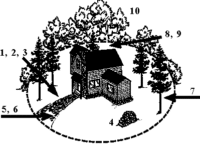- 08, 06, 2015
- No Comments.
- By admin
Wildfire Preparedness for Horse Owners – 1.817
Print this fact sheet by N. Striegel (3/14)* Quick Facts… The safety of you and your family should be the first priority. The greatest factor in limiting your losses during a wildfire is having and using a preparedness plan. An equine first aid kit is essential for all horse owners to have in the barn […]
Take a Tour- 08, 06, 2015
- No Comments.
- By
Conifer Seed Bugs – 5.588
Print this fact sheet by W.S. Cranshaw* (7/14) Quick Facts… Conifer seed bugs are a common fall and winter nuisance in Colorado homes. They develop on seeds of various plants, particularly pines. They have a somewhat bizarre appearance and may produce a piney defensive odor when disturbed. However, they are harmless to people and do […]
Take a Tour- 08, 06, 2015
- No Comments.
- By
Cockroaches – 5.553
Print this fact sheet by F.B. Peairs * (6/12) Quick Facts… Cockroaches are associated with filth and unsanitary conditions. Known to carry disease organisms, they have not been tied to major disease outbreaks in the United States. Egg cases, nymphs and adults can be found in an infested area. Eliminate unnecessary sources of water, food […]
Take a Tour- 08, 05, 2015
- Comments Off on Soil Erosion Control after Wildfire – 6.308
- By admin
Soil Erosion Control after Wildfire – 6.308
Print this fact sheet by R. Moench and J. Fusaro* (1/12) Quick Facts… The most immediate consequence of fire is the potential for soil erosion. Intense heat from fire can make the soil repel water, a condition called hydrophobicity. Landowners should take quick action to minimize erosion once it’s safe to return to the property: […]
Take a Tour- 08, 05, 2015
- No Comments.
- By admin
Forest Home Fire Safety – 6.304
Print this fact sheet by F.C. Dennis * (1/12) Quick Facts… Take steps now to protect your home from a future wildfire. This can spell the difference between your property’s destruction or survival. During a wildfire, law enforcement officials may ask you to evacuate with little warning. Take precautions now to prepare for that possibility. […]
Take a Tour- 08, 05, 2015
- No Comments.
- By admin
FireWise Plant Materials – 6.305
Print this fact sheet By S. Carter, N. Goeckner, C. Julian (CSFS), L. Langelo, I. Shonle and C. Dennis (Emeritus CSFS) (4/23) Quick Facts… Introduction In Colorado, in the wildland-urban interface (WUI), it isn’t a matter of if a wildfire will impact residences and properties, but when. The WUI includes any areas where structures and […]
Take a Tour- 08, 05, 2015
- No Comments.
- By admin
Fire-Resistant Landscaping – 6.303
Print this fact sheet by F.C. Dennis * (1/12) Quick Facts… More people are moving into Colorado’s rural areas, increasing the chances of wildfire. “Defensible space” is the primary determinant of a structure’s ability to survive wildfire. Native species are generally the best plant materials for landscaping in defensible space, but others can be grown […]
Take a Tour- 08, 04, 2015
- No Comments.
- By admin
Addressing the Impacts of Wildfire on Water Resources – 6.706
Print this fact sheet by R. Waskom, J. Kallenberger, B. Grotz, and T. Bauder* (12/14) Quick Facts… Fire damage to ground level and underground structures can lead to well contamination and malfunction of wastewater systems. Well owners need to inspect and test well and septic systems following impact by wildfire. Wildfire impacts to irrigation water […]
Take a Tour- 08, 04, 2015
- No Comments.
- By
Carpenter Ants – 5.554
Print this fact sheet by F.B. Peairs * (8/10) Quick Facts… Large black or brown carpenter ants, winged or wingless, can cause serious damage if permitted to remain in the structural wood of a building. Winged carpenter ants often are mistaken for termites, a more serious problem. Winged ants inside or outside a home year-round […]
Take a Tour- 08, 04, 2015
- No Comments.
- By
Boxelder Bugs – 5.522
Print this fact sheet by F.B. Peairs* (12/14) Quick Facts… Boxelder bugs are a nuisance in and around homes from fall through early spring. The bug overwinters as an adult in protected places such as houses or other buildings. Removing female boxelder trees is the most permanent solution to the problem, although this may not […]
Take a Tour












